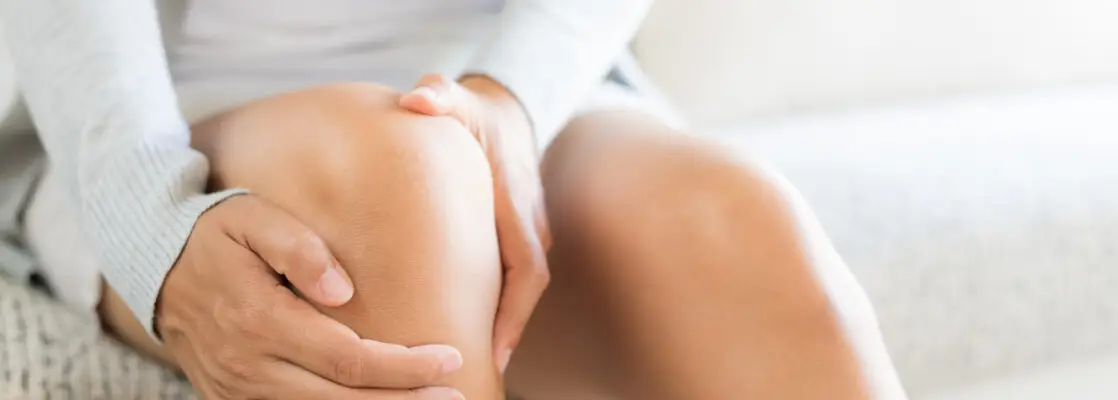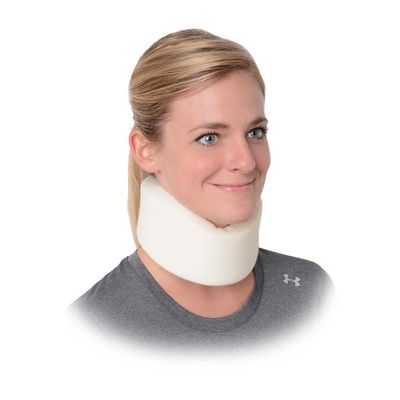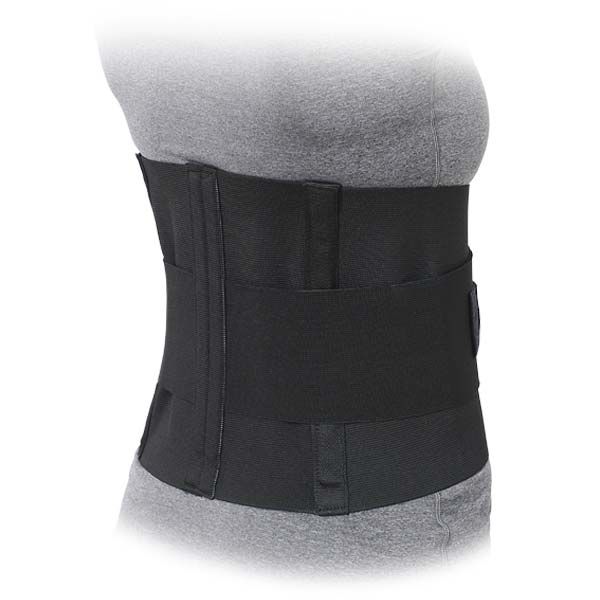
Lumbar Sacral = Back Support W/ Side Pulls
A back support with side pulls is a type of orthopedic brace designed to provide stability, compression, and support to the lower back, particularly in cases of lower back pain, injury, or strain. The addition of side pulls allows for adjustable compression and increased support, helping to alleviate pain and promote proper posture.
Key Features of a Back Support with Side Pulls
Adjustable Side Pulls
- Side pulls are adjustable straps or laces that allow users to tighten or loosen the brace as needed. This feature provides customizable compression and support to the lower back, enhancing comfort and effectiveness.
- The side pulls allow for easy adjustments throughout the day, accommodating changes in comfort level or activity.
Lumbar Support
- The brace is designed to target the lumbar region (lower back), providing support to the spine and surrounding muscles. This can help reduce stress on the back and prevent further injury.
Compression
- The compression provided by the brace helps reduce swelling and inflammation, which can lead to pain relief. Compression also promotes better posture and can improve muscle engagement in the lower back.
Breathable Material
- Many back supports with side pulls are made from breathable, moisture-wicking materials to ensure comfort during extended use. This helps reduce heat buildup and prevents skin irritation.
Ergonomic Design
- Designed to fit the natural curves of the back, the support is contoured to provide a snug and comfortable fit. The side pulls enable adjustments to fit a variety of body shapes and sizes.
Velcro or Hook-and-Loop Fastening
- The brace is usually secured with Velcro or hook-and-loop fasteners, allowing users to easily adjust the tightness for optimal support.
Uses of a Back Support with Side Pulls
Lower Back Pain Relief
- Ideal for people suffering from lower back pain due to muscle strain, overuse, or conditions like sciatica or herniated discs. The side pulls provide extra support to stabilize the lower back and alleviate pain.
Posture Improvement
- Helps correct poor posture by providing lumbar support and encouraging a more upright position. This can be particularly helpful for individuals who spend long hours sitting or standing in improper positions.
Injury Prevention
- Used by athletes, manual laborers, or individuals who perform heavy lifting to prevent lower back injuries. The brace adds extra stability to the spine and reduces the risk of strain or injury.
Post-Surgical Support
- Provides stability and reduces strain on the lower back following surgery or injury, promoting a faster recovery and preventing reinjury.
Chronic Back Conditions
- Beneficial for individuals with chronic back conditions such as degenerative disc disease, osteoarthritis, or lumbar stenosis. The adjustable side pulls allow for consistent support based on the level of discomfort.
Benefits of Back Support with Side Pulls
- Customizable Compression: The adjustable side pulls enable the user to tighten or loosen the brace, providing the right amount of compression based on activity level or pain.
- Improved Stability: By stabilizing the lower back and promoting proper posture, the brace helps reduce strain on the spine and surrounding muscles.
- Pain Relief: Compression and support can alleviate pain caused by injury, muscle strain, or chronic back conditions.
- Enhanced Mobility: Many users find that the brace allows them to continue daily activities with less pain, while still supporting their back.
How to Use a Back Support with Side Pulls
- Position the Brace: Center the back support over your lower back (lumbar region), ensuring it is sitting comfortably.
- Fasten the Brace: Secure the front closure (typically Velcro) around your abdomen. The brace should fit snugly but not too tight to restrict breathing or movement.
- Adjust Side Pulls: Tighten or loosen the side pulls as needed to customize the level of compression and support. Make sure the brace feels secure and provides adequate support without causing discomfort.
- Wear During Activity: Use the back support during activities that may strain your lower back, such as lifting, bending, or prolonged sitting/standing. You can also wear it during exercise if advised by a healthcare provider.
- Do Not Overuse: While a back support can be helpful for pain relief and injury prevention, it’s important not to become overly reliant on the brace. Overuse can lead to weakened back muscles. Gradually work on strengthening your back through physical therapy or exercises.
Care and Maintenance
- Follow the manufacturer’s instructions for cleaning and maintaining the back support. Most are hand-washable or machine-washable in a gentle cycle.
- Ensure that the brace is fully dry before wearing it again to prevent skin irritation or damage to the materials.
A back support with side pulls can be an effective tool for managing back pain, supporting posture, and preventing injury. It’s ideal for those with lower back issues who need adjustable support for varying levels of activity and comfort.
ORDER NUMBER: 501-W, 503-W, 505-W, 507-W, 507-W, 508-W, 509-W, 510-W, 511-W, 512-W
501-B, 503-B, 505-B, 507-B, 508-B, 509-B, 510-B, 511-B, 512-B
SIZE: X-Small thru 5X Large (see sizing chart to the left)
PRODUCT HIGHLIGHTS:
• Form-fitting 10" all-elastic with double pull side panels for additional support
• High quality Velcro™ closure for durability
• Four flexible stays in back panel for excellent support
INDICATIONS:
Ideal for providing support and compression for strains and sprains of the lower back.
SUGGESTED HCPC: L0625
Categories: Cervical, Spine & Abdominal


Table of Contents
Orthopedic Knee Brace
Knee braces are a versatile orthopedic solution designed to provide support, stability, and protection for the knee joint, particularly in cases of injury, post-surgery recovery, or chronic conditions. What makes knee braces unique is the combination of functionality, material innovation, and adaptability for various medical conditions and activities.
Targeted Support for a Range of Conditions
Knee braces are developed to cater to specific knee injuries and conditions, such as:
- Ligament Injuries: ACL (anterior cruciate ligament), PCL (posterior cruciate ligament), MCL (medial collateral ligament), and LCL (lateral collateral ligament) injuries. Specialized hinged braces stabilize and prevent lateral movement.
- Arthritis: Unloader knee braces are designed to relieve pressure on the knee joint in individuals with osteoarthritis, reducing pain and improving mobility.
- Meniscus Tears: Functional braces stabilize the knee, preventing further damage while the meniscus heals.
- Patellar Tracking Issues: Knee braces with patellar stabilization help guide the kneecap and prevent it from moving out of alignment, a common issue with conditions like patellofemoral pain syndrome (runner’s knee).
Types of Knee Braces
- Prophylactic Braces: These are used by athletes to prevent knee injuries during contact sports.
- Rehabilitative Braces: Often prescribed post-surgery or after a significant injury, these braces restrict movement to aid healing.
- Functional Braces: Designed for people with existing injuries, providing support while allowing some movement for day-to-day activities.
- Unloader Braces: Primarily for individuals with osteoarthritis, they redistribute weight away from the affected part of the knee joint to reduce pain and improve mobility.
Material Innovation for Enhanced Comfort and Durability
Knee braces incorporate high-quality materials for maximum comfort and effectiveness. Some of the commonly used materials include:
- Neoprene: A flexible, breathable material that provides gentle compression and warmth, enhancing circulation and reducing swelling.
- Nylon and Polyester Blends: Lightweight and durable, often used in the outer layers to add structure and resilience.
- Metal or Plastic Hinges: Used in more rigid braces for mechanical support, allowing controlled movement.
- Gel Pads or Foam Inserts: Provide cushioning, particularly for individuals with patellar issues or osteoarthritis, enhancing comfort during movement.
Customization and Fit
Knee braces come in both custom-made and off-the-shelf models. Custom knee braces are fitted specifically to an individual’s leg, ensuring a perfect fit for maximum support and comfort. Off-the-shelf braces offer adjustable straps, allowing patients to modify tension and compression as needed.
Balancing Mobility and Stability
One of the key aspects of knee braces is their ability to strike a balance between stability and mobility. Athletes, for instance, rely on braces that support the joint while allowing them to remain active. Braces designed for ACL injuries, for example, provide rigid support to prevent side-to-side movement, while allowing forward and backward mobility.
Prevention and Performance
Enhancement
In addition to injury management, knee braces are used proactively by athletes to prevent knee injuries. By offering added stability, compression, and protection during high-impact sports, braces help reduce the risk of ligament tears or hyperextension, allowing athletes to push their performance with confidence.
Revolutionary Designs and Technology Integration
Some modern knee braces integrate **smart technology or biofeedback sensors to track motion, monitor knee stability, and offer real-time insights. This data can help both patients and healthcare professionals adjust rehabilitation strategies, optimizing recovery.
Unique Selling Points:
Dual-Functionality: Many knee braces combine both compression and support, helping in both pain relief and structural integrity.
- Innovative Designs: Lightweight yet durable materials ensure that even heavy-duty braces do not inhibit movement.
- Recovery-Boosting Technologies: Features like temperature-regulating fabrics, moisture-wicking linings, and customizable compression levels are designed to enhance recovery while maintaining comfort.
Knee braces are a unique blend of technology, medical innovation, and user-friendly design that address a wide range of needs, making them invaluable for both athletes and individuals with chronic conditions.
Knee Pain
Knee Pain is a common issue that can affect people of all ages. It can result from injuries, overuse, or underlying conditions such as arthritis. The knee is a complex joint, composed of bones, cartilage, ligaments, and tendons, which all work together to provide support and mobility. When any of these structures are damaged or inflamed, it can result in pain and difficulty with movement.
Causes of Knee Pain:
Injury:
- Ligament injuries (such as an ACL tear) are common in athletes.
- Meniscal tears can occur from twisting the knee or direct impact.
- Fractures of the knee bones due to trauma or falls.
Arthritis:
- Osteoarthritis: A degenerative condition that wears down the cartilage in the knee joint over time.
- Rheumatoid arthritis: An autoimmune condition that can inflame the knee joint.
- Tendonitis: Inflammation of the tendons, often from overuse, particularly common in runners (patellar tendonitis).
- Bursitis: Inflammation of the bursae (fluid-filled sacs that cushion the knee), often caused by kneeling for extended periods.
- Obesity: Excess weight places extra strain on the knee joint, contributing to pain and the likelihood of developing arthritis.
Symptoms of Knee Pain:
- Swelling and stiffness in the knee.
- Weakness or instability when standing or walking.
- Popping or crunching sounds when moving the knee.
- Inability to fully straighten the knee.
- Pain that worsens with physical activity or after long periods of sitting.
Treatment and Management:
- Rest and Activity Modification: Reducing physical activity to avoid exacerbating pain.
- Physical Therapy: Strengthening the muscles around the knee to improve stability and flexibility.
- Medications: Over-the-counter pain relievers like ibuprofen or prescription anti-inflammatory drugs can help manage symptoms.
- Bracing: Wearing a knee brace to support and stabilize the knee joint.
- Injections: Corticosteroid injections may be used to reduce inflammation.
- Surgical Options: In severe cases, procedures like knee arthroscopy or knee replacement surgery may be required.
Prevention:
- Maintaining a healthy weight to reduce stress on the knees.
- Strengthening the muscles around the knee, particularly the quadriceps and hamstrings.
- Warming up before exercise and using proper techniques during physical activities.
Knee pain can greatly impact daily life, but with the right treatment, most individuals can manage their symptoms and maintain mobility.






